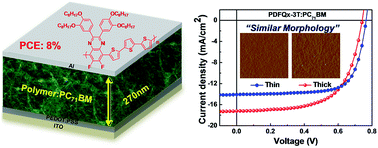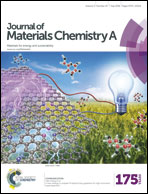Quinoxaline–thiophene based thick photovoltaic devices with an efficiency of ∼8%†
Abstract
A series of difluoroquinoxaline–thiophene based reduced band gap polymers was designed and synthesized by considering non-covalent coulombic interactions in a polymeric main chain. The insertion of different numbers of thiophene moieties allows for the adjustment of the absorption range, frontier energy levels, crystalline self-organization, film morphology and the resulting photovoltaic properties. A thick blend film of poly(thiophene-alt-(2,3-bis(3,4-bis(octyloxy)phenyl)-6,7-difluoroquinoxaline)) (PDFQx-T):[6,6]-phenyl-C71-butyric acid methyl ester (PC71BM) showed a rough, inhomogeneous and largely phase-separated surface morphology compared to a typical film with ∼100 nm thickness. A similar trend was observed in the surface morphology of a poly(2,2′-bithiophene-alt-(2,3-bis(3,4-bis(octyloxy)phenyl)-6,7-difluoroquinoxaline)) (PDFQx-2T) blend film, showing deteriorated photovoltaic properties with increasing film thickness. In contrast, poly(2,2′:5′,2′′-terthiophene-alt-2,3-bis(3,4-bis(octyloxy)phenyl)-6,7-difluoroquinoxaline) (PDFQx-3T) had a similar blend film morphology for both thick and thin active layers, showing a homogeneous and smooth morphology with a face-on orientation and tight π–π stacking (d-spacing = 3.6 Å). The optimized photovoltaic cell based on PDFQx-3T : PC71BM achieved a power conversion efficiency (PCE) of 8% with an open-circuit voltage of 0.74 V, a short-circuit current of 17.19 mA cm−2 and a fill factor of 0.63 at an active layer thickness of ∼270 nm. It is still a challenge to develop photovoltaic polymers which allow efficient charge transport and extraction at a device thickness of ∼300 nm. Fine-adjustment of intra- and interchain interactions must be considered carefully to achieve high device properties for thick devices without deterioration in the blend morphology and charge recombination. This high PCE at an active layer thickness of ∼300 nm may suggest great potential for the mass production of printed polymer solar cells via industrial solution processes.


 Please wait while we load your content...
Please wait while we load your content...